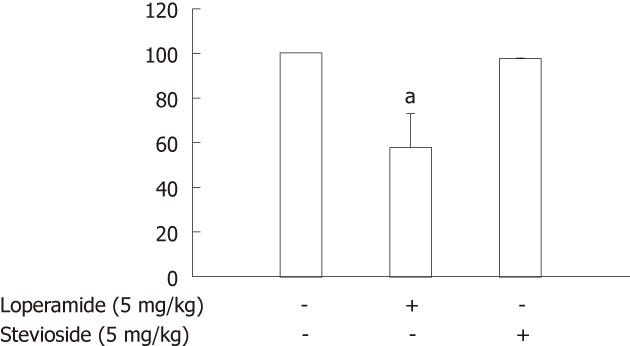Copyright
©2012 Baishideng Publishing Group Co.
World J Gastroenterol. Mar 28, 2012; 18(12): 1391-1396
Published online Mar 28, 2012. doi: 10.3748/wjg.v18.i12.1391
Published online Mar 28, 2012. doi: 10.3748/wjg.v18.i12.1391
Figure 1 Role of opioid μ-receptors in gastrointestinal tract using charcoal as an indicator.
The data represent the distance (A) and time (B) for the transit of charcoal. Data represent the mean ± SEM of eight animals. bP < 0. 01 vs the distilled water (vehicle)-treated control.
Figure 2 Inhibitory effect of cyprodime or naloxonazine on relaxation induced by loperamide (10 μmol/L) in isolated ileum contracted with 1 μmol/L acetylcholine.
Data represent the mean ± SEM of the percentage changes in the acetylcholine (ACh)-induced tonic contraction of ileum from eight animals. bP < 0.01 vs the distilled water (vehicle)-treated control.
Figure 3 Effect of stevioside on the tone of isolated ileum strips contracted with 1 μmol/L acetylcholine.
Data represent the mean ± SEM of the percentage changes in the acetylcholine (ACh)-induced tonic contraction of ileum from eight animals. aP < 0.05 vs the distilled water (vehicle)-treated control, shown in the first column.
- Citation: Chen W, Chung HH, Cheng JT. Opiate-induced constipation related to activation of small intestine opioid μ2-receptors. World J Gastroenterol 2012; 18(12): 1391-1396
- URL: https://www.wjgnet.com/1007-9327/full/v18/i12/1391.htm
- DOI: https://dx.doi.org/10.3748/wjg.v18.i12.1391















